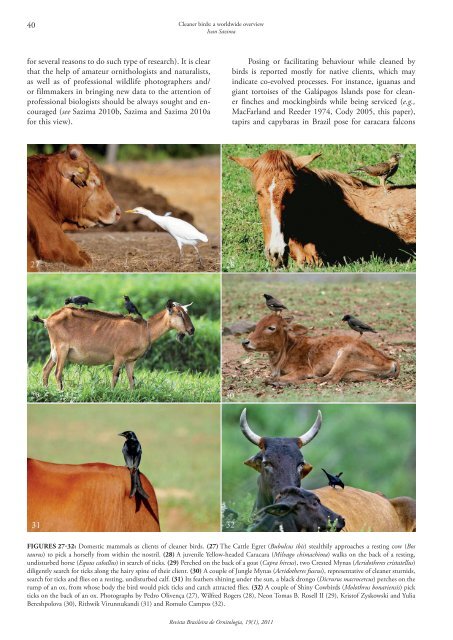Capa 19(1) - fechada.indd - Sociedade Brasileira de Ornitologia
Capa 19(1) - fechada.indd - Sociedade Brasileira de Ornitologia
Capa 19(1) - fechada.indd - Sociedade Brasileira de Ornitologia
You also want an ePaper? Increase the reach of your titles
YUMPU automatically turns print PDFs into web optimized ePapers that Google loves.
40 Cleaner birds: a worldwi<strong>de</strong> overview<br />
Ivan Sazima<br />
for several reasons to do such type of research). It is clear<br />
that the help of amateur ornithologists and naturalists,<br />
as well as of professional wildlife photographers and/<br />
or filmmakers in bringing new data to the attention of<br />
professional biologists should be always sought and encouraged<br />
(see Sazima 2010b, Sazima and Sazima 2010a<br />
for this view).<br />
Posing or facilitating behaviour while cleaned by<br />
birds is reported mostly for native clients, which may<br />
indicate co-evolved processes. For instance, iguanas and<br />
giant tortoises of the Galápagos Islands pose for cleaner<br />
finches and mockingbirds while being serviced (e.g.,<br />
MacFarland and Ree<strong>de</strong>r <strong>19</strong>74, Cody 2005, this paper),<br />
tapirs and capybaras in Brazil pose for caracara falcons<br />
Figures 27‐32: Domestic mammals as clients of cleaner birds. (27) The Cattle Egret (Bubulcus ibis) stealthily approaches a resting cow (Bos<br />
taurus) to pick a horsefly from within the nostril. (28) A juvenile Yellow-hea<strong>de</strong>d Caracara (Milvago chimachima) walks on the back of a resting,<br />
undisturbed horse (Equus caballus) in search of ticks. (29) Perched on the back of a goat (Capra hircus), two Crested Mynas (Acridotheres cristatellus)<br />
diligently search for ticks along the hairy spine of their client. (30) A couple of Jungle Mynas (Acridotheres fuscus), representative of cleaner sturnids,<br />
search for ticks and flies on a resting, undisturbed calf. (31) Its feathers shining un<strong>de</strong>r the sun, a black drongo (Dicrurus macrocercus) perches on the<br />
rump of an ox, from whose body the bird would pick ticks and catch attracted flies. (32) A couple of Shiny Cowbirds (Molothrus bonariensis) pick<br />
ticks on the back of an ox. Photographs by Pedro Olivença (27), Wilfred Rogers (28), Neon Tomas B. Rosell II (29), Kristof Zyskowski and Yulia<br />
Bereshpolova (30), Rithwik Virunnukandi (31) and Romulo Campos (32).<br />
Revista <strong>Brasileira</strong> <strong>de</strong> <strong>Ornitologia</strong>, <strong>19</strong>(1), 2011

















